I. Background and Motivation
Food waste can be defined as any food that is discarded, lost, or eaten. Although food waste may seem like a small issue, it is a much larger problem in the grand scheme of things. This issue is a part of the sustainability and environmental crises happening throughout the world and specifically in our case, Ireland. According to the Department of Communications, Climate Action, and Environment, there is over one million tons of food waste disposed of each year in Ireland. One third of this food waste comes from households, every household is responsible for approximately one ton of food waste each year.
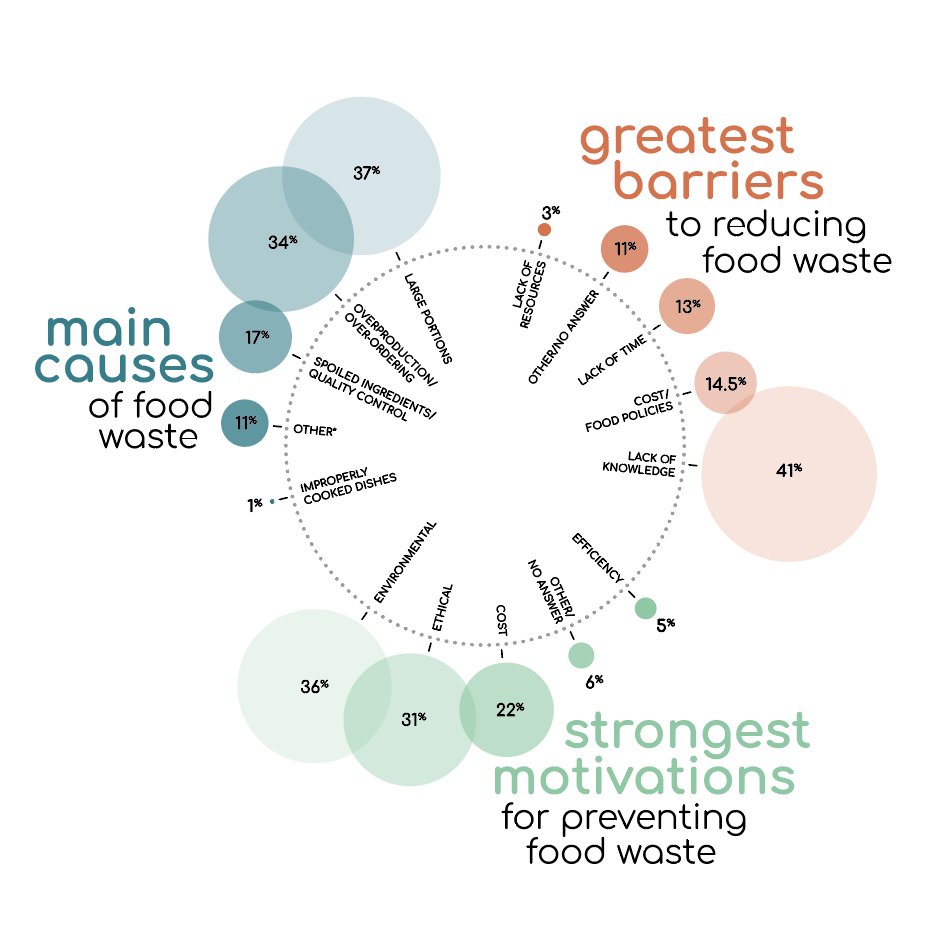
Due to this overwhelming number, Ireland has taken a variety of green initiatives to combat the issue of food waste in households. Galway City Council Bio-Waste Regulations are designed to “promote the segregation and beneficial use of food waste arising in commercial sectors and households.” These new regulations are put on the generators of food waste which includes a general prohibition on the disposal of food waste into a general waste bin. This is separated into a three bin system that includes compost, recyclables, and trash. Authorized waste collectors are then required to collect the separate trash and dispose of it correctly. Since this disposal of waste has been implemented heavily on a variety of facilities, as a group we wanted to see how it is specifically implemented in Galway. Galway is going to be awarded the 2020 European Capital of Culture and it is important to see how the restaurants being the driving force behind the culture practice sustainability as well.
We referenced other surveys done in our research. We looked at a questionnaire on food waste on survey monkey. It focuses on the individual’s opinion and determining what category of food is the most wasted. We came up with our own questions but borrowed from verbiage in this survey to aid in receiving accurate results. Our survey’s goal was to assess how big of an issue food waste is in Galway, what waste management programs are in place, and how restaurants perceive their waste. Our questions were aimed at achieving an accurate and fair assessment of Galway’s food waste.
Department of Communications, Climate Action and Environment
Galway City Council
II. Methodology
We began this survey curious about the perceptions of food waste in the restaurants, bars, bakeries, and cafes in Galway. We decided not to survey bodegas, supermarkets, and international chains because they didn’t fit our target of sit-down eateries. We split up into three groups and surveyed 83 restaurants. We divided Galway into three areas: Westend, City Center, and Eyre Square. As the survey went on, we expanded these areas so as to not overlap. Our questions were a result of preliminary research, as well as early surveys we did to see which questions were relevant to what we wanted to find out about. The survey began as a short answer questionnaire, however, after surveying about 15 restaurants, we decided that a seven question multiple-choice survey would better suit our data. These questions were: What does your restaurant do with food waste? In an average day, what percentage of the food purchased by your facility goes to waste? Out of the food unused, which category is most often wasted? What is the primary cause of food waste in your restaurant? What is the biggest barrier or challenge when trying to prevent food waste? What is your biggest motivation for trying to prevent food waste? On a scale of 1-10 (1=not a problem, 10=big problem) how big of a problem is food waste in your restaurant? Participants were restaurant workers of various positions, such as barista, waiter, manager, owner, and chef. Our method of surveying was to simply go into the various restaurants and ask if anybody who worked there was available to take our survey. If they were not, we often found that places were willing to take the survey and do it before we came back the next day. There were times when the worker at the counter may not have been knowledgeable about food waste, in this case, we would leave the survey for a manager or chef to take later. The conditions of the survey were that it was anonymous for the workers and the restaurant; however, we did take down the name of the restaurant for data compiling purposes. In the first week of surveying, we had Foroige youth come survey with us. They provided insight on which potential questions to ask and places to include in the survey, and they were also switching between the three groups of surveyors in order to see how each group was able to interact with the people of Galway and extract the necessary information.
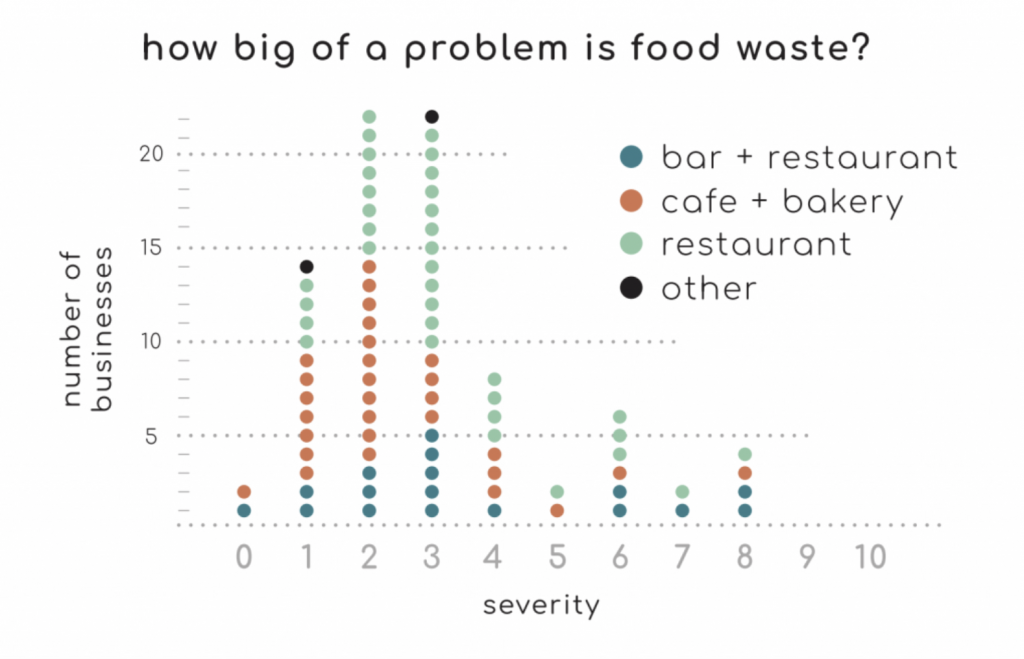
III. Results
Looking at the results of the food waste survey, 47% of the restaurants surveyed reported only 0-10% of their food goes to waste. The category of food that was most wasted by 48% of restaurants asked were fruits/vegetables. When asked what the primary cause of food waste was in their facility, 37% of the restaurants stated that large portion sizes were at fault and 34% stated that overproduction/overordering was to blame. Most restaurants reported that their biggest barrier when it comes to preventing food waste was lack of knowledge at 41%. The response of the facilities when asked what their biggest motivation was when trying to prevent food waste followed with 31% responding for ethical reasons and 36% for environmental consciousness. When asking about any of the food waste programs in place, 42% of restaurants responded that they compost. The final question asked of these facilities was how big of a problem was food waste in their facility on a scale from 1-10 and the responses of 2 and 3 were the same at 26.5%. In comparison, a survey taken in 2017 found that Ireland as a nation wastes 1.1 million tons of food each year with restaurants responsible for 34% which is 380,000 tons of food.
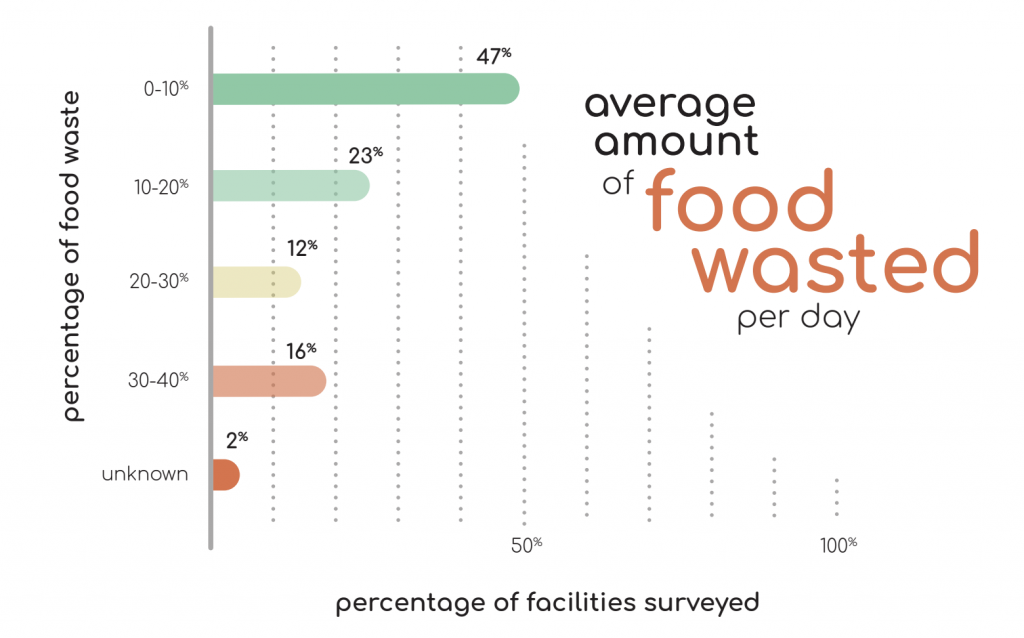
It should be noted that the restaurants of this survey are under bias due to the fact the restaurants were not professionally audited and the respondents of the survey varied in their positions at the restaurants. Because of this, there can be skewed results for a number of questions. It was also a fairly small sample size which can also influence the results. Many restaurants were also dismissive of the survey or refused to answer the questions all together. Despite this, many restaurants agreed to take part.
Fruits and vegetables were often the most wasted category of food. This can be due to the fact that they spoil the most quickly and are the products usually left uneaten by customers (i.e. side salads). These leftover sides could be the customer accidentally over ordering, and then not wanting or asking for a take-away box. Our interviewees also noted that fruit peels and garnishes are perceived the most wasted by many restaurant employees.
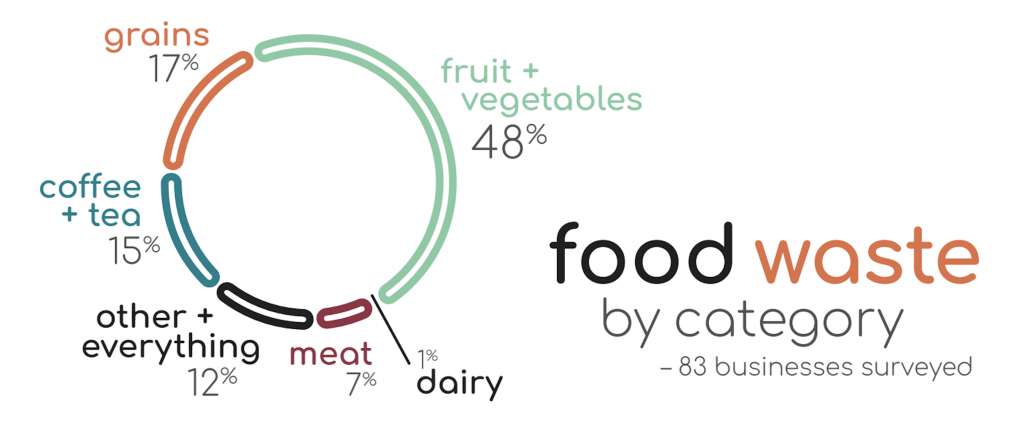
The majority of restaurants main food waste program was composting. This is because policies require generators of food waste to have a three bin program as stated prior. Several restaurants made note of the fact that they used to donate their leftover food to people in need but they are now unable to do so due to current food hygiene laws. Some are still allowed to donate to charities, but this proves to be difficult because often, charities do not have the room for the food being donated or do not have the time necessary to pick it up. A surprising number of restaurants admitted to throwing out food and not having a food waste program in place.
Many restaurants perceived food waste in their facility as a small issue and rated it as a 2 or 3 on a scale of 1 (not a problem) to 10 (a large problem). Although they reported it as a small issue, they would occasionally report that they threw out food or that they wasted a large percentage of food daily. This question was the most challenging to measure due to the fact the boundaries were difficult to specify and vary restaurant to restaurant. Due to the subjectivity of the question, many restaurants found it difficult to respond to.
IV. Conclusion
Preventing and reducing food waste is a global issue today. There are several problems that arise when there is too much food going unused and thrown into landfills. The byproducts created when food waste is broken down greatly damages the environment from creating unlivable areas near the landfills to producing greenhouse gases that are slowly warming the earth. There are also millions of people that struggle to find food everyday that could be fed by the amount of food thrown away every year. Policy changes at the governmental level will go a long way in trying to reduce this problem.
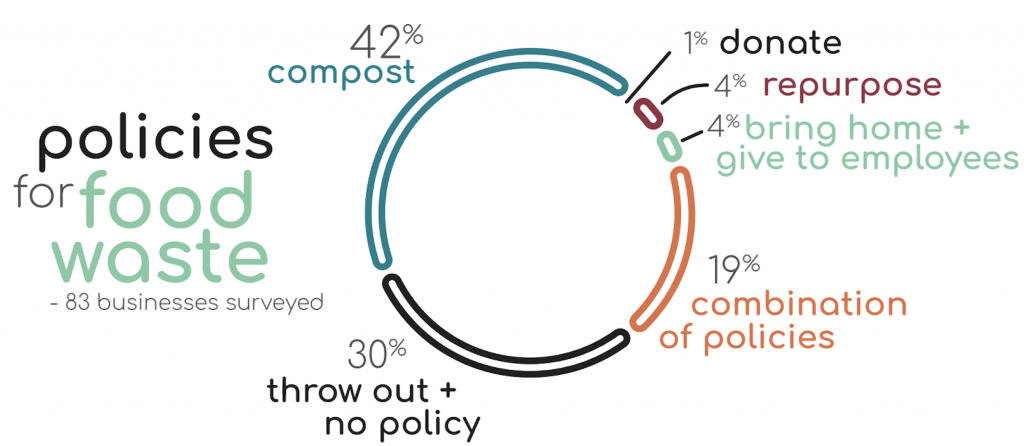
Based on our findings, there are some changes that Galway could implement to reduce food waste. Firstly, a large issue that was seen across facilities was Ireland’s food policies. Restaurants that were once allowed to donate their leftover food at the end of the night to people in need are no longer able to do so. A new policy was created stating that donating unused or uneaten food was in violation of food hygiene laws. This policy, while meant to protect people from food poisoning, was mostly to protect restaurants and the city from any civic court cases. If there is a way to combat this new policy, there could be regulations limiting the number of people that could come into contact with food that could later be donated in order to promote food safety while also preventing food waste. Another way to combat this policy is to have more organizations like COPE, an organization that takes all the liability off grocery stores and restaurants. They collect any unused food that facilities have in surplus and distribute it to people in need. By having more organizations like this that can work around the policies already in place, it gives smaller establishments the opportunity to give away surplus food rather than being forced to throw it out.
The responses to this survey proves that people do care about the problem of food waste because the majority of the restaurants stated that they wanted to reduce food waste for both ethical and environmental reasons. The problem is that these restaurants simply don’t have enough resources or knowledge about how to change what they are currently doing. This is similar to issues in the US regarding food waste because there are not many programs in place that promote donating or reducing the amount of food waste created. There are a serious lack of resources for restaurants that want to reduce their eco-footprint. A way to combat partly combat these issues is to educate the public about the importance of repurposing food. Many respondents didn’t even know how big of an issue this is globally, much less in Galway. By introducing more awareness campaigns, establishments with the means to lessen their food waste may be able to make a change.
By Megan Petersen, Rebecca Gill, Megan Stewart, Callie Carlstrom, Morgan Grant, and Jessica Kronzer
With special thanks to Mark O’Boyle and Benjamin Hopley for their assistance in surveying and for their local expertise